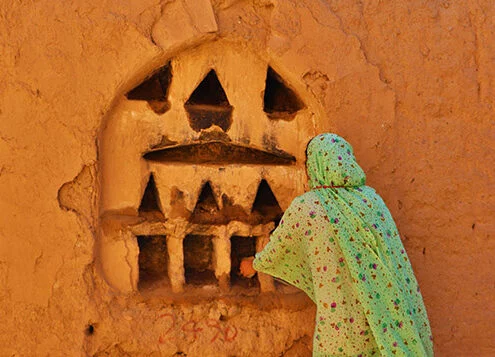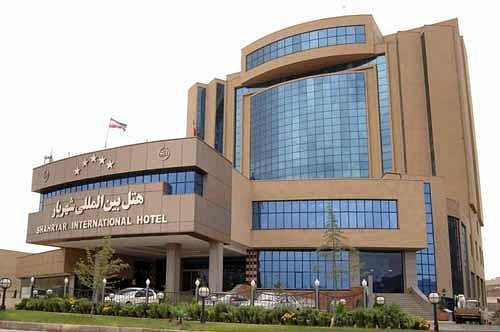Tehran Metro is a vital and efficient means of transportation in one of the most populated cities in Iran and the Middle East. It helps you avoid traffic and travel quickly across the city at a low cost. The metro network has expanded over the years with new lines and stations, providing better access to various parts of the city, including the suburbs. Whether you’re commuting to work or exploring Tehran’s attractions, knowing the map and operating hours of the metro will make your travel easier and more convenient.
Metro Map of Tehran: An Essential Tool for Navigation
Viewing the Tehran Metro map will help you plan your journey and choose the quickest route to your destination. The map is available in all metro stations and in most metro carriages. However, note that newer stations may not always be shown on some of the maps in the stations.
Most of the metro stations and lines are concentrated in the central part of Tehran, as this area sees the highest volume of traffic. Many locals use the same routes daily, often traveling between home and work.
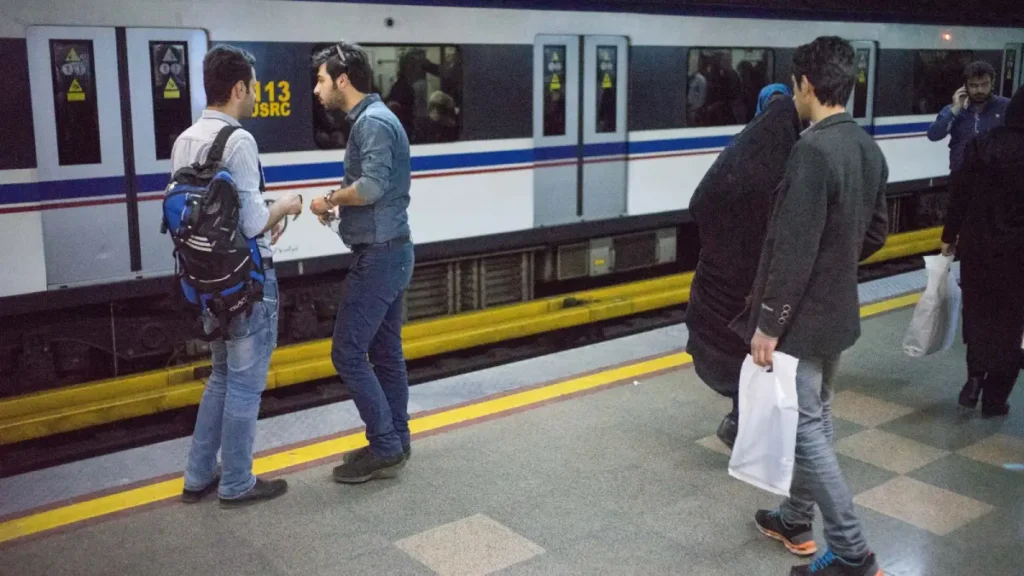
Different Types of Metro Cards and Payment Methods in Tehran
Since the opening of the first Tehran Metro line at Sadeghieh station, various types of tickets have been introduced. Initially, paper tickets were used, followed by magnetic cards, and now smart cards are in use. These smart cards can be recharged and used for travel not only on the metro but also on buses and BRTs. You can buy and recharge these cards at designated stations or use kiosks available throughout the city.
If you frequently use the metro, a smart card is the most convenient and cost-effective option, allowing you to recharge as needed and pay lower fares. For cash payments, fares are rounded as follows: 70,000 rials for urban trips, 80,000 rials for suburban trips, 170,000 rials for Shahid Sepahbod Qasem Soleimani Station (Hashtgerd), and 230,000 rials for Parand Station.
Of course, these rates apply for 2025 and may be subject to change.
How to Purchase and Recharge Metro Cards
To buy a smart metro card, simply visit one of the ticket counters at metro stations or BRT terminals in Tehran. No identification is required to purchase the card. The cost of a smart card is 15,000 rials, and you can recharge it as many times as needed. These tickets are convenient because they can also be used for other public transport services in Tehran.
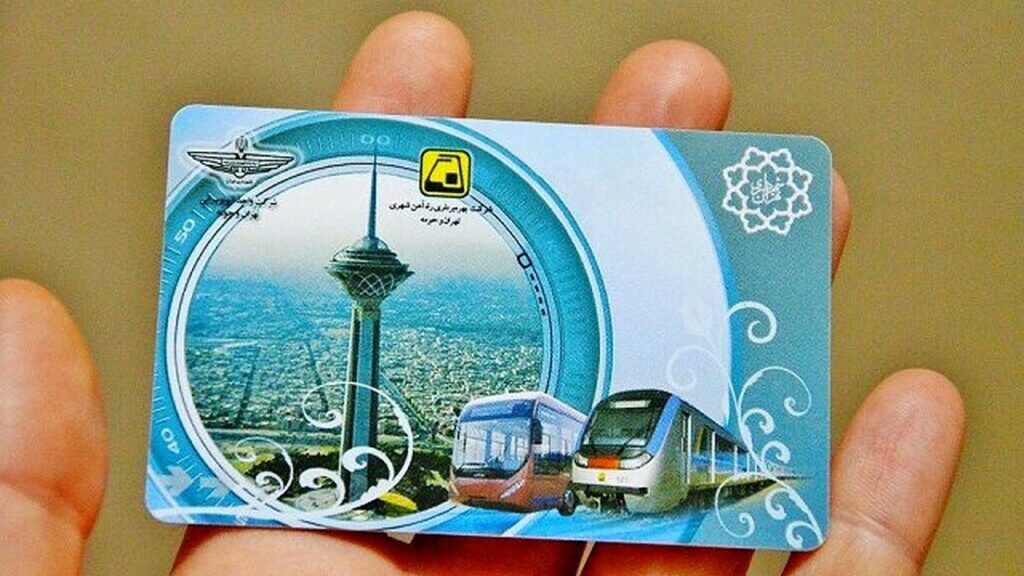
Active Metro Stations in Tehran
The Tehran Metro network is continually expanding, providing more connections within the city and to the surrounding areas, including Karaj. However, many stations are still under construction or are not yet operational. As of now, numerous stations are either in the planning or construction stages, and some are yet to be launched. You can use the metro map to get an overview of the available stations and lines.
Tehran Metro Lines Map
Line 1: Tajrish to Kahrizak (Red Line)
Line 1 is the longest metro line in Tehran and connects the north and south of the city. It has 29 active stations and spans a distance of 37.5 kilometers. The line operates from 5:30 AM to 10:30 PM and serves many important locations in Tehran, such as the Golestan Palace, Tehran Grand Bazaar, and the National Jewels Museum. This line is highly convenient for both locals and tourists.
The stations on Line 1 are Tajrish, Qeytarieh, Shahid Sadr, Gholhak, Dr. Shariati, Mirdamad, Shahid Haghani, Shahid Hemmat, Mosala Imam Khomeini, Shahid Beheshti, Shahid Mofatteh, Shahid Heftom Tir, Taleghani, Darvazeh Dowlat, Saadi, Imam Khomeini, Panzdah Khordad, Khayyam, Meydan Mohammadieh, Shoosh, Payaneh Jonoob, Shahid Bokharaei, Aliabad, Javaneh Sardasht, Shahr Rey, Palayeshgah, Shahed – Baqer Shahr, Haram Imam Khomeini, and Kahrizak.
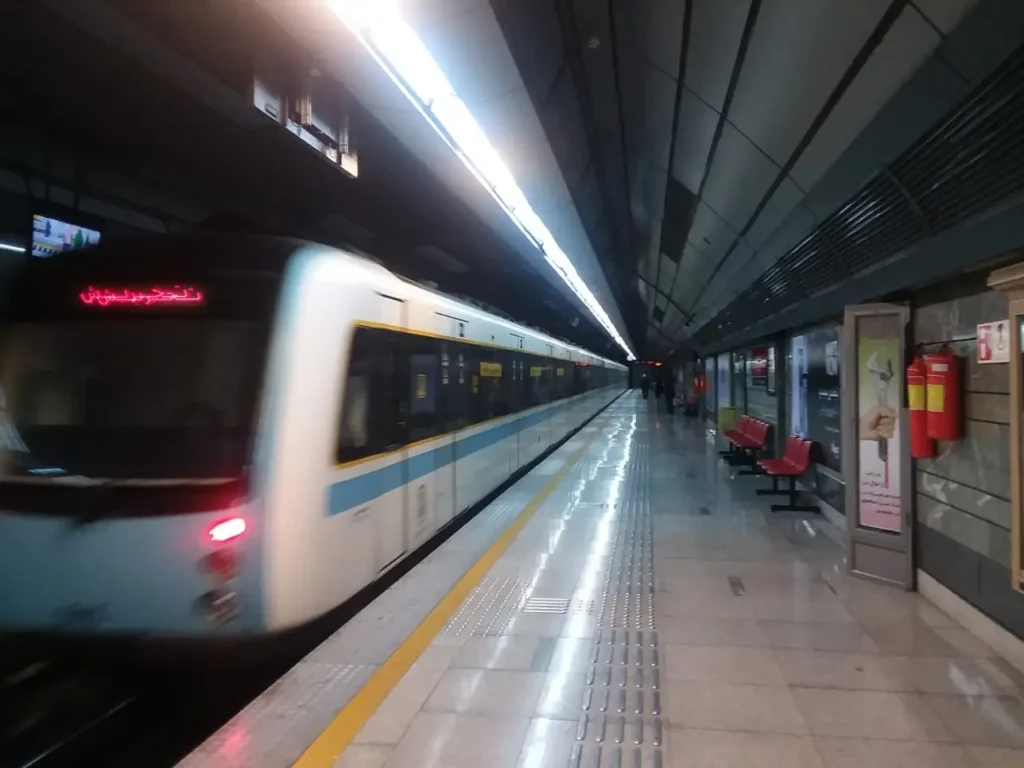
Line 2: Sadeghieh to Farhangsara (Dark Blue Line)
Line 2 is one of the busiest lines in Tehran, running from east to west and connecting 22 stations over a distance of 22 kilometers. This line operates during the same hours as Line 1, and the travel time from end to end is approximately 45 minutes. Some notable landmarks along this route include the Tehran Pars Forest Park and the Miniature Museum.
Here’s the list of stations: Sadeghieh, Tarasht, Sharif University, Shadman, Shahid Navab Safavi, Meydan Har, Imam Ali University, Hasanabad, Imam Khomeini, Mellat, Baharestan, Darvazeh Shamirran, Imam Hossein, Shahid Madani, Sablon, Fadak, Janbazan, Sarsabz, Daneshgah Elm va Sanat, Shahid Baqeri, Tehranpars, Farhangsara.
Line 3: Qaem to Azadegan (Light Blue Line)
Line 3 travels from north to south, covering a distance of 33.7 kilometers. It has 25 stations, though some are still under construction. The full journey on this line takes about 60 minutes. Line 3 connects key areas of Tehran, including Tehran University and Azadegan Square, making it an important route for students, commuters, and travelers. This line also passes through major residential neighborhoods and commercial hubs, providing easy access to various parts of the city.
Here’s the list of stations: Qaem, Shahid Mohammadi, Eqdasiya, Nobonyad, Hossein Abad, Meydan Heravi, Shahid Zeynaldin, Khwaja Abdullah Ansari, Shahid Sayad Shirazi, Shahid Qodusi, Sohravardi, Shahid Beheshti, Mirzaei Shirazi, Meydan Jihad, Meydan Hazrat Vali Asr, Tatr Shahr, Moniriyeh, Mahdieh, Rah Ahan, Javadiyeh, Zamzam, Shahrak Shariati, Abdol Abad, Nemat Abad, Azadegan.
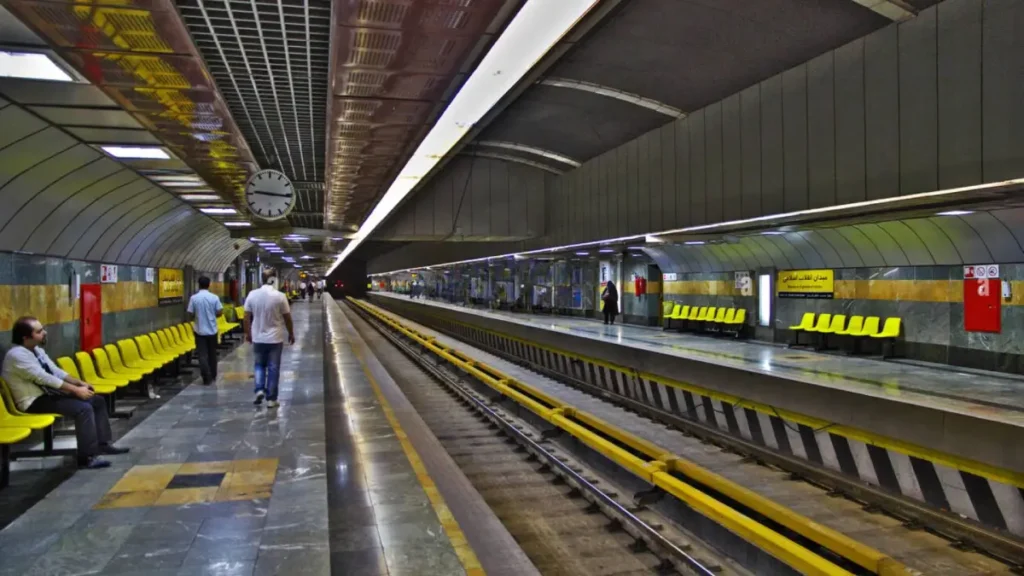
Line 4 – Shahid Kolahdooz – Eram Sabz (Yellow)
Line 4 of Tehran’s metro, marked in yellow on the map, is one of the busiest lines. It covers a distance of 21 kilometers, with a total travel time of around 42 minutes from start to end. Operating daily from 5:30 AM to 10:30 PM, this line serves both commuters and tourists. It consists of 19 stations, beginning at Shahid Kolahdooz (located at the start of Doran Highway) and ending at Eram Sabz (next to Eram Park).
Several key stations on this line provide access to important landmarks. Nirowe Havaei, Nabard, and Piroozi stations are located in residential areas, while Revolution Square (Meydan Enqelab Eslami) is a central hub near universities and bookstores. You can visit popular attractions such as the House of Artists near Ferdowsi Station, City Theater, and Vahdat Hall near the City Theater Station, Azadi Tower near Azadi Square, and Laleh Park near Revolution Square.
Here’s the list of stations: Shahid Kolahdooz, Air Force, Nabard, Piroozi, Ibn Sina, Meydan Shahda, Darvazeh Shemiran, Darvazeh Dowlat, Ferdowsi, Tatr Shahr, Meydan Enqelab Eslami, Towhid, Shadman, Dr. Habibollah, Ostad Moien, Meydan Azadi, Bimeh, Shahrak Ekbatan, Eram Sabz, Allameh Jafari.
Line 5 – Golshahr – Sadeghieh (Green)
Line 5 of Tehran’s metro, marked in green on the map, connects the Golshahr area in Karaj to Sadeghieh in Tehran. Covering a distance of 42 kilometers, it takes approximately 57 minutes to travel from one end to the other. This line is essential for commuters traveling between Tehran and Karaj, one of Iran’s largest cities. It operates daily from 5 AM to 10:30 PM.
With 11 stations, Line 5 provides access to key locations. Golshahr, located in Karaj, serves as a major hub for travelers heading to Tehran. Iran Khodro Station is close to Iran’s largest car manufacturing company. Chitgar Station offers easy access to Chitgar Park, the Bamlend Mall, and Chitgar Lake, a popular recreational area. Azadi Stadium Station is the nearest stop for visiting the Azadi Sports Complex, Iran’s largest stadium.
Here’s the list of stations: Golshahr, Mohammad Shahr, Karaj, Atmosphere, Garmdareh, Vardavard, Iran Khodro, Chitgar, Azadi Stadium, Eram Sabz, Tehran (Sadeghiyeh).
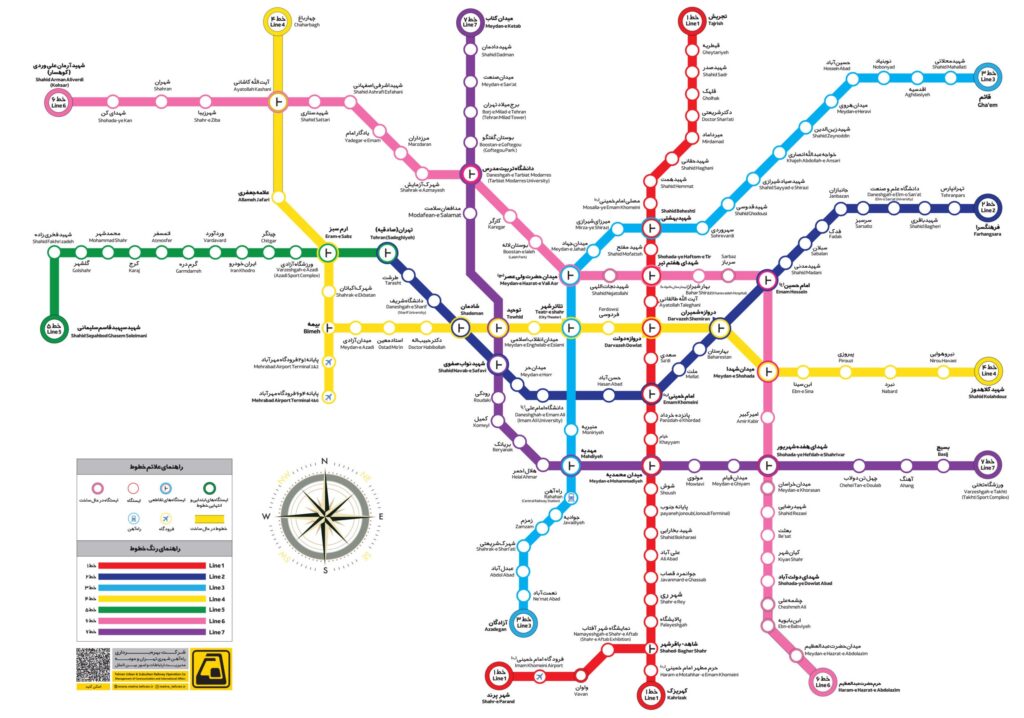
Line 6 – Dolatabad – Imam Hossein and Shahid Sattari – Tarbiat Modares University (Pink)
Line 6 of Tehran’s metro, marked in pink on the map, is one of the newest additions to the network. Spanning 27 kilometers, it currently has 17 stations, with some still under construction. The line operates between Dolatabad in the southeast and the Shahid Sattari intersection in the northwest. Trains run at 15-minute intervals, making it a convenient option despite being a newer line.
Several key stations serve important locations. Imam Hossein Station connects to other major metro lines, making transfers easier. Tarbiat Modares University Station is ideal for students and faculty traveling to the university area. Bostan Laleh Station provides access to Laleh Park, a popular green space in central Tehran.
Here’s the list of stations: Shahdaye Dolatabad, Kian Shahr, Basat, Shahid Rezaei, Amir Kabir, Meydan Shahda, Imam Hossein, Shahdaye Haftom Tir, Meydan Hazrat Vali Asr, Bostan Laleh, Kargar, Tarbiat Modares University, Shahrak Azmayesh, Marz Daran, Yadgar Imam, Shahid Ashrafi Esfahani, Shahid Sattari, Shahr Ziba, Shahran, Shahid Arman Ali Vardi.
Line 7 – Basij – Industry Square (Purple)
Line 7 of Tehran’s metro, marked in purple on the map, is one of the newest lines in the network. It spans 23 kilometers and currently has 20 stations. Trains operate at 12-minute intervals, running between Basij in the east and Industry Square (Meydan San’at) in the west.
This line connects several key locations. Meydan Ketab Station provides access to the National Library and Archives of Iran. Milad Tower Station is the closest stop to Tehran’s famous Milad Tower, a major landmark with a panoramic view of the city. Briyank Station is near the Wildlife Museum, and Meydan San’at Station is close to historic sites and business centers.
Here’s the list of stations: Meydan Ketab, Shahid Dadman, Meydan San’at, Milad Tower, Bostan Goftogo, Tarbiat Modares University, Modafe’an Salamat, Towhid, Shahid Navab Safavi, Roudaki, Kamil, Briyank, Helal Ahmar, Mahdieh, Meydan Mohammadiyeh, Molavi, Meydan Qiam, Shahdaye Heftom Shahrivar, Chehel Tan Dolab, Ahang, Basij.
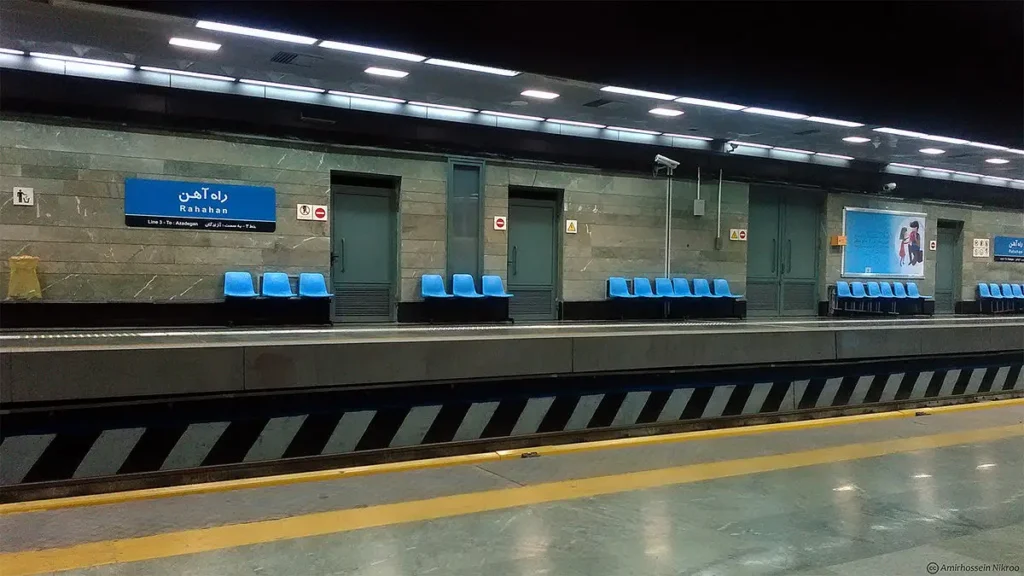
Tehran Metro Branch Lines
Tehran Metro has several branch lines which are not part of the main routes but offer convenient connections to different parts of the city:
- Imam Khomeini Airport Branch Line: A branch of Line 1 connecting Shahid Station to Imam Khomeini International Airport. It covers a distance of 30 kilometers and takes 40 minutes. This line operates between 7 AM and 7:20 PM.
- Mehrabad Airport Branch Line: A 2-kilometer branch of Line 4 linking the city to Mehrabad Airport. It travels in just 4 minutes, with operating hours from 5:30 AM to 10:30 PM.
- Hashtgerd Branch Line: A branch of Line 5 connecting Golshahr to Shahid Sepahbod Qasem Soleimani in Hashtgerd. It spans 26 kilometers and takes 40 minutes. It operates from 8 AM to 3:40 PM.
Operating Hours of Tehran Metro
The metro generally operates from 4:30 AM to 10 PM on weekdays. On weekends and public holidays, operation starts at 6 AM. Some lines have slightly adjusted timings depending on the day of the week.
Contact and Additional Information
For any inquiries, you can reach out to Tehran Metro’s customer service at:
- Phone: +98 21 66712216
- Email: [email protected]
- Website: metro.tehran.ir
On the official website, you can find detailed information about station schedules, train times, metro maps, travel planning, ticket information, and other services.
Easy Metro Ticket Purchases and More
The Visit Our Iran debit card makes travel in Iran incredibly easy. You can quickly buy metro tickets, pay for taxis, and shop at local stores with just a tap. The card is accepted at many points of sale across the country, allowing you to move around without worrying about currency exchange or carrying cash.
Whether you need to grab a quick snack, buy a souvenir, or get a ride, the Visit Our Iran debit card has you covered. It’s a secure, fast, and convenient way to manage your travel expenses, giving you more time to enjoy the sights and experiences Iran has to offer.
With the Visit Our Iran SIM card, you can stay connected to the internet, use local apps for navigation and services, and make calls to friends and family, all while using the same card for payment. This seamless experience ensures that your trip is smooth and stress-free from start to finish.
